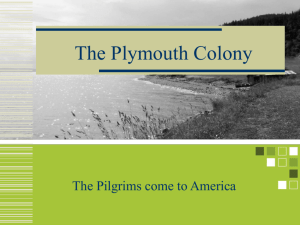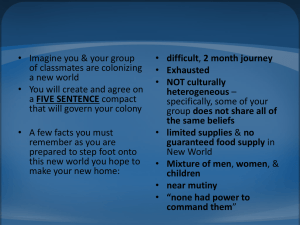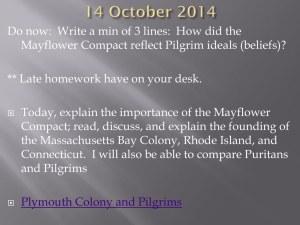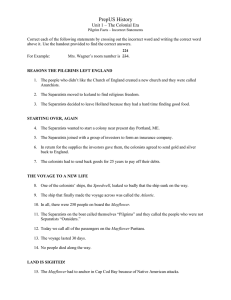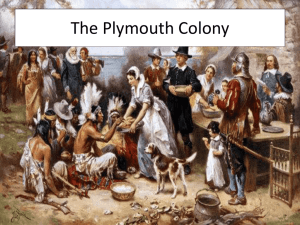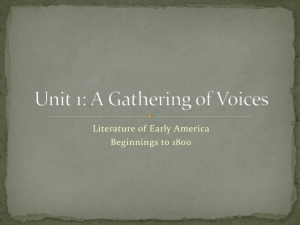PrepUS History Unit 1 – The Colonial Era
advertisement
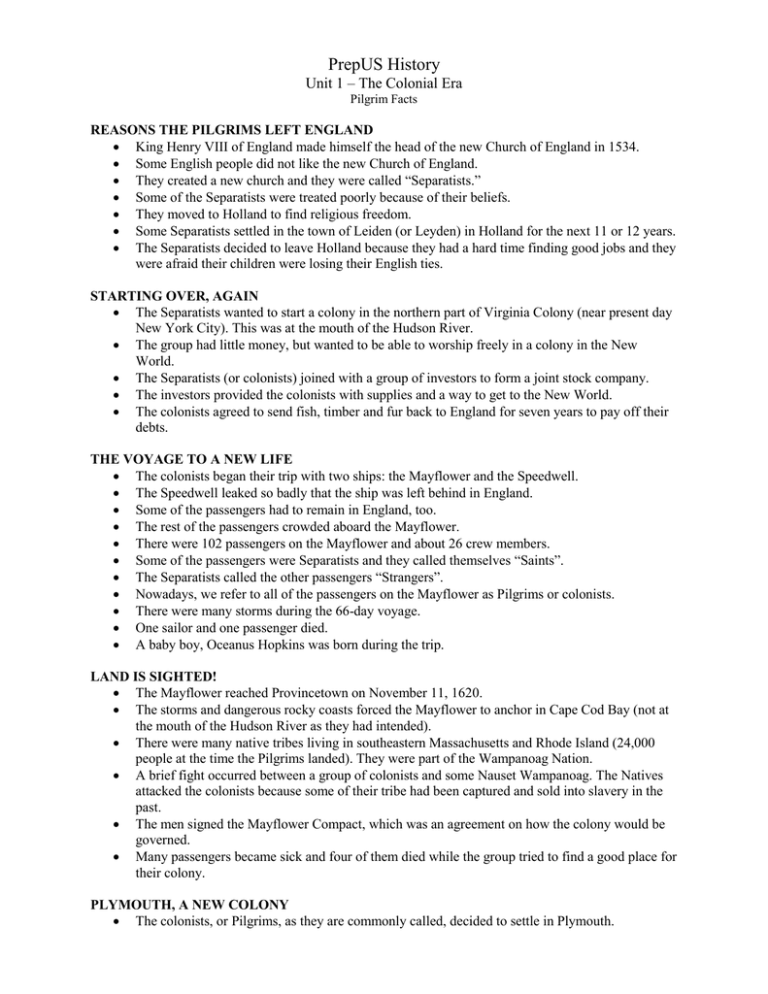
PrepUS History Unit 1 – The Colonial Era Pilgrim Facts REASONS THE PILGRIMS LEFT ENGLAND King Henry VIII of England made himself the head of the new Church of England in 1534. Some English people did not like the new Church of England. They created a new church and they were called “Separatists.” Some of the Separatists were treated poorly because of their beliefs. They moved to Holland to find religious freedom. Some Separatists settled in the town of Leiden (or Leyden) in Holland for the next 11 or 12 years. The Separatists decided to leave Holland because they had a hard time finding good jobs and they were afraid their children were losing their English ties. STARTING OVER, AGAIN The Separatists wanted to start a colony in the northern part of Virginia Colony (near present day New York City). This was at the mouth of the Hudson River. The group had little money, but wanted to be able to worship freely in a colony in the New World. The Separatists (or colonists) joined with a group of investors to form a joint stock company. The investors provided the colonists with supplies and a way to get to the New World. The colonists agreed to send fish, timber and fur back to England for seven years to pay off their debts. THE VOYAGE TO A NEW LIFE The colonists began their trip with two ships: the Mayflower and the Speedwell. The Speedwell leaked so badly that the ship was left behind in England. Some of the passengers had to remain in England, too. The rest of the passengers crowded aboard the Mayflower. There were 102 passengers on the Mayflower and about 26 crew members. Some of the passengers were Separatists and they called themselves “Saints”. The Separatists called the other passengers “Strangers”. Nowadays, we refer to all of the passengers on the Mayflower as Pilgrims or colonists. There were many storms during the 66-day voyage. One sailor and one passenger died. A baby boy, Oceanus Hopkins was born during the trip. LAND IS SIGHTED! The Mayflower reached Provincetown on November 11, 1620. The storms and dangerous rocky coasts forced the Mayflower to anchor in Cape Cod Bay (not at the mouth of the Hudson River as they had intended). There were many native tribes living in southeastern Massachusetts and Rhode Island (24,000 people at the time the Pilgrims landed). They were part of the Wampanoag Nation. A brief fight occurred between a group of colonists and some Nauset Wampanoag. The Natives attacked the colonists because some of their tribe had been captured and sold into slavery in the past. The men signed the Mayflower Compact, which was an agreement on how the colony would be governed. Many passengers became sick and four of them died while the group tried to find a good place for their colony. PLYMOUTH, A NEW COLONY The colonists, or Pilgrims, as they are commonly called, decided to settle in Plymouth. The Pilgrims arrived in Plymouth Harbor on December 16, 1620. The Patuxet Wampanoag had lived in Plymouth before the Pilgrims. About 2000 Patuxet died in a plague that occurred between 1616 and 1619. The plague was probably smallpox, brought to the New World by Europeans. Only one Patuxet, Squanto, did not die from the plague. He had been captured and sold into slavery in 1614 and was living in England when the rest of his tribe died. The Pilgrims found that the old Patuxet lands had many things they needed: 1. A good harbor 2. A clean supply of water (Town Brook) 3. Fields which were already cleared 4. No hostile native people 5. A hill upon which they could build a fort. A TOUGH, SAD BEGINNING The Pilgrims began to build houses onshore in Plymouth. Most of the people lived on the Mayflower while the houses were being started. People began to get very sick. They had pneumonia and scurvy. Poor food, exposure to bad weather and the stress of the voyage caused the illnesses. Two or three Pilgrims died every day during the first two months that they were in Plymouth. 47 Pilgrims died during the first year. Half of the Mayflower’s crew died. The Mayflower and her crew returned to England on April 5, 1621. All of the colonists chose to remain in Plymouth. TWO CULTURES MEET Samoset, a Native from the Monhegan tribe in Maine who spoke English, walked into Plymouth on March 16, 1621. He greeted the Pilgrims by saying, “Welcome, Englishmen! My name is Samoset.” Samoset returned to Plymouth on March 22. He brought Massasoit with him. Massasoit was a Pokanoket Wampanoag sachem (leader). Governor Bradford and Massasoit signed a peace treaty. Squanto, the only surviving member of the Patuxet tribe, also came to visit. Squanto and Hobbamock lived at Plymouth Plantation. They helped the colonists to gather food, plant corn, find their way in the wilderness and to understand the native people. THANKSGIVING, 1621 In October 1621 the Pilgrims had a three-day celebration to give thanks for their first harvest. There were games, singing, and plenty of food. Massasoit and 90 other Wampanoag attended the celebration. The Wampanoag brought much of the food. This celebration eventually became the holiday we know as Thanksgiving. INTERESTING TIDBITS ABOUT CHILDREN Five year old Pilgrims worked around the home by fetching wood, getting water, doing errands and herding geese. Older children harvested fruit, fertilized, and helped clear fields. Still older boys helped with the plowing and hunting while girls about the age of twelve took care of younger siblings, sewed, cooked meals, helped with the harvest, and did housework. Some of the games children played were cards, marbles, leapfrog, football, doll playing, and tops. Parents constantly corrected and disciplined their children. Colonists thought the Native people were too lenient with their young. CHILDREN’S CLOTHING Young boys (to about age 8) and girls both wore dresses (“gowns”), made of either wool or linen. The skirt was full length. The bodice, which laced in the back, was long sleeved and had a high neckline. The color blue was common for children, as well as gray, red, earthy greens, yellows, and browns. About the age of seven to nine, boys began to wear clothing similar to their fathers, and girls began to wear dresses cut more like those of their mothers. OLDER GIRLS’ AND WOMEN’S CLOTHING A woman’s undergarment was a short-sleeved, linen shirt that was tied at the collar and cuffs and fastened in the front. One or more petticoats were worn. The dress, or gown, consisted of two parts, a bodice and a skirt. Sometimes the sleeves were a separate part and tied to the bodice. The bodice or the skirt was made of wool and could be the same or different colors. A bodice buttoned down the front. The skirt was gathered at the waist and fell to the ankle. A long-sleeve fitted waistcoat was generally worn. Women always wore aprons when working. Sometimes women wore lace collar and cuffs, and a cloak. Women wore their hair pulled tightly back. They wore a coif (bonnet) or hat. Women’s clothes were usually red, earthy green, browns, blue, violet, and gray. Black and white clothing was not normally worn. OLDER BOYS’ AND MEN’S CLOTHING Men wore a short-sleeved shirt that was long in length. A doublet, a close-fitting vest, with long sleeves, was worn. A cloak was worn. Most men wore lace collars and cuffs. A felt hat was worn. Older or more revered men often wore a full-length wool gown over the top of their other clothes. Breeches were worn. Stockings were knee-length. Shoes were low-heeled, leather shoes. The most common colors for men’s clothes were white, beige, black, earthy green, and brown. Buckles were not worn. Black clothing was worn on Sunday or formal occasions, not every day. PLYMOUTH AFTER THANKSGIVING, 1621 John Billington, Jr. got lost in the woods outside of Plymouth in July of 1621. He lived on berries for five days and finally wandered into Manomet, a Wampanoag village twenty miles from his home. Not knowing what to do with him, the Natives sent him on to the Nauset tribe. They returned him to Plymouth with strings of beads around his neck. In November, 1621 the ship the Fortune landed at Plymouth with 35 new colonists. The original Pilgrims had barely enough food for themselves, and little to spare for more people. During the next three years the Pilgrims would often be short on food supplies and had to trade with the Natives and ration their food. The colonists had little help from the investors in England when they had some poor farming years in addition to many new colonists. In September 1622 Squanto died. In 1623 each colonist was given one acre of land to farm in order to help get better food supplies and to keep people happy. The colonists did not own this land, but they were allowed to farm it. A very bad drought occurred in the spring and early summer of 1623. The Pilgrims held a day of prayer and fasting known as a Day of Humiliation in order to end the drought. By the end of the Day of Humiliation it began to rain. A Day of Thanksgiving was held to thank God for ending the drought. Sixty new colonists arrived in July 1623 on the Anne followed by more people on board the Little James. Most of the newcomers were the relatives of the people who had come over on the Mayflower. In 1625 the investment company which had financed Plymouth Colony disbanded. The company had made very little money. They were concerned about the Pilgrim’ religious practices as stories had been brought back to England by some returning colonists who had been unhappy living in Plymouth. The colonists were forced to take on the debt of the colony. It took them many years to finally pay it off. The houses and livestock were divided up amongst the colonists in 1627 so that they owned them. Individual families were given their own land in 1628. Foods Available to the Pilgrims for 1621 Thanksgiving FISH:cod, bass, herring, shad, bluefish, and lots of eel. SEAFOOD:clams, lobsters, mussels, and very small quantities of oysters. BIRDS:wild turkey, goose, duck, crane, swan, partridge, and other miscellaneous waterfowl. OTHER MEAT:venison (deer), possibly some salt pork or chicken. GRAIN:small quantity of wheat flour (from England), Indian corn and corn meal, barley (mainly for beer making). FRUITS:raspberries, strawberries, grapes, plums, cherries, blueberries, gooseberries (these would have been dried, as none would have been in season). VEGETABLES:small quantity of peas, squashes (including pumpkins), beans. NUTS:walnuts, chestnuts, acorns, hickory nuts, ground nuts. DRINKS:beer (the primary drinking beverage for everyone), possibly grape wine, hard liquor similar to whiskey or brandy, and springhead water. OTHER:maple syrup, honey, small quantities of butter, Holland cheese, and eggs.
